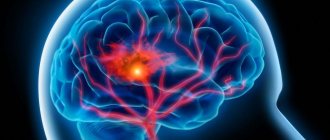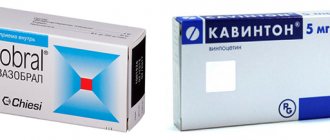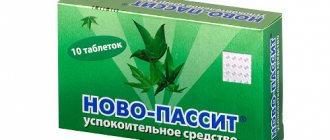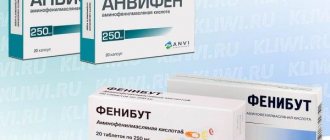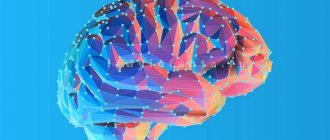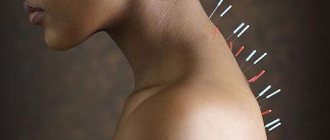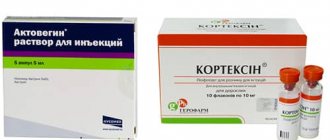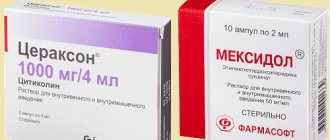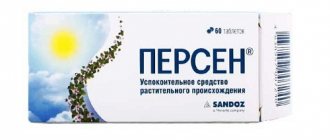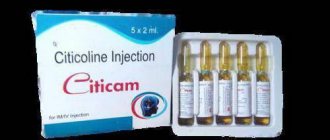Nootropic medications are used to treat and prevent blood flow disorders in the brain in patients of all ages. Nootropics are also prescribed to maintain the psycho-emotional state of women during pregnancy and lactation. Cortexin and Cerebrolysin are often prescribed in these cases, so it is worth figuring out what is best to take in each case for the treatment of brain pathologies and other neurological disorders.
Cerebrolysin has the properties of neurotrophic activity - replacing the functionality of dead neuron molecules.
Main differences
So, what is the difference between Cortexin and Actovegin?
The first medication is successfully used in therapies for dyscirculatory encephalopathy. The same cannot be said about Actovegin. For this pathology, this medication is only applicable in combination with the first one. Doctors practice injections of drugs one at a time, every other day. Cortexin is the only medication that is suitable for treating children with central nervous system injuries. Its use usually gives good results.
Cortexin copes more effectively with hypoxic and traumatic brain damage. Although Actovegin works well in the treatment of vegetative-vascular dystonia, it can provoke nervous-reflex overexcitation. Therefore, if the patient is prone to hysteria or nervous attacks, it is better to carry out therapy with Cortexin.
Both medications are rarely used at the same time, since serious allergic reactions are likely, but such a prescription is possible.
Answers on questions
- Cerebrolysin - prescription or not?
Yes, the drug is a prescription and is used as prescribed by a doctor. The dosage and course of treatment are also determined by a specialist. - How is Cerebrolysin administered - intravenously or intramuscularly?
The method of administration is determined by the doctor based on the patient’s condition, severity of the disease, and age. Medicine up to 5 ml is administered intramuscularly, up to 10 ml intravenously, over 10 ml is prescribed in the form of droppers with other approved solutions. - Does Cerebrolysin increase or decrease blood pressure?
Among the side effects when using the medicine and exceeding the dosage are arrhythmia, increased heart rate, increased or decreased blood pressure.
Indications and restrictions
Taking Cortexin is indicated in the following cases:
- diseases of the central nervous system of viral and bacterial etiology;
- disturbances of blood flow in brain tissue;
- TBI of varying degrees of complexity and their consequences;
- diffuse brain damage of various nature;
- cerebral autonomic disorders. In combination with other drugs, it is used for the treatment of epilepsy, as well as for the treatment of acute and chronic diseases of the brain and spinal cord. The drug is prescribed not only for adults, but also for children. For small patients, it is suitable for increasing mental abilities, with delayed psychomotor and speech development, and various forms of cerebral palsy.
Actovegin is used much more often, in particular, for:
- stroke;
- skull injuries;
- encephalopathies;
- ulcers;
- varicose veins;
- endarteritis;
- angiopathy of various etiologies;
- bedsores;
- burns;
- radiation damage to the skin;
- endocrine and neurological disorders. The medication is indicated for difficult pregnancies and the threat of miscarriage. It has a beneficial effect on the health of the pregnant woman and the fetus. In childhood, treatment is carried out only under the strict supervision of a doctor.
Contraindications for Cortexin are:
- excessive sensitivity to the components of the drug;
- periods of gestation and pregnancy.
Actovegin is not recommended for use if the patient has:
- pulmonary edema;
- kidney diseases;
- heart failure;
- fluid retention.
A limitation for the use of the drug may be ordinary intolerance to the components. Therefore, before using it, make a control test. This is especially true for children.
Indications for use
What are they? The drug "Cerebrolysin", analogues of which have a similar effect, is used for a variety of forms of neurological and psychiatric pathologies, which are accompanied by a disorder of cognitive functions. The main indications include:
- dementia syndrome - vascular or senile dementia, Alzheimer's disease;
- cerebrovascular insufficiency;
- brain injuries;
- lack of attention and hyperactivity in children;
- depression that is resistant to antidepressants;
- senile dementia;
- ischemic stroke;
- delayed intellectual development.
The principle of action of the drugs
Cortexin includes soluble neuropeptides that quickly act on the central nervous and circulatory systems. The medication regulates brain neurotrophic factors, as well as the normal ratio of amino acids in the brain.
Cortexin is characterized by the following properties:
- antioxidant;
- neuroprotective;
- nootropic.
Mechanism of action
It increases the intensity of metabolism of neurons in the central nervous system and PNS, stimulates reparative processes in the central nervous system, and improves the functional state of the cerebral cortex. It has a beneficial effect on the somatic and vegetative systems.
Actovegin is a universal metabolic stimulant. Provides improved tissue nutrition and oxygen saturation. Promotes the production of ATP, which is responsible for the normal functioning of all systems in the body.
With local action, under the influence of a healing substance, wounds heal faster, and the scar remains barely noticeable. Tissue respiration processes are activated. Oxygen is distributed throughout the body evenly.
The formation of collagen fibers improves, as well as the growth, division and distribution of cells. The medicine improves energy exchange in the brain, meets its glucose needs, and normalizes the functioning of the central nervous system.
Composition, active ingredient Cortexin
It is produced in the form of lyopholisate - a white or yellowish powdery substance intended for the manufacture of solutions.
Packaged in bottles of 5 and 10 mg.
The main component is cortexin.
Nootropic effect:
- activates brain activity;
- improves memory and learning ability;
- increases attentiveness;
- increases stress resistance.
The neuroprotective effect is reduced to protecting neurons from free radicals, calcium ions, and glutamate. The effect of psychotropic medications is mitigated.
Antioxidant Capacity:
- stops oxidative degradation of lipids;
- enhances the viability of neurons during oxygen starvation and oxidative stress.
The tissue-specific property contributes to:
- activation of metabolic processes in neurons of both the central and peripheral nervous system;
- improving brain function and the state of the nervous system.
Cortexin injections are prescribed for children and adults. If the patient weighs over 20 kg, the dosage is the same: 10 mg once a day for 10 days. Then a break of 10 days is arranged, after which a repeat course is given: 1 bottle of lyophilisate per day.
The solution is not intended for storage, so it must be used immediately.
Cortexin analogues and prices
The following Cortexin analogues have the same ATC codes. Analogues are selected according to the chemical structure of the drug and are the most suitable substitutes. Same composition, indications for use, doses of active ingredients may differ.
Compound:
cortexin
All analogues of Cortexin are presented for informational purposes only and are not a reason for making an independent decision about replacing the drug. Before using the drug, consult your doctor and read the instructions for use.
Cerebrolysin or Piracetam
Piracetam is an analogue of Cerebrolysin in tablets, capsules and injections. The drug is weaker because it has a nootropic effect, improves metabolism in brain cells, and affects the properties of blood cells.
The main indications for the use of the analogue are the treatment of cognitive impairment after a stroke or other organic brain lesions, the treatment of decreased attention, dizziness, and tinnitus. Not used for hemorrhagic stroke.
Piracetam is produced by manufacturers under the following trade names:
- Piracetam;
- Lutsetam;
- Nootropil.
It is also included in complex preparations with cinnarizine - Phezam, Nookam, Omaron.
What to choose from analogues, consult your doctor.
Cerebrolysin and Cortexin comparison of drugs
Both nootropic drugs stimulate metabolic processes in the tissues of the nervous system. This reaction ensures the nutrition and development of brain cells (neurons). Improved metabolism allows new cells to quickly form to replace damaged ones.
Cerebrolysin and Cortexin are neuropeptides, that is, protein molecules formed in the nervous system. These substances are characterized by high biological activity, which makes it possible to achieve the following effect:
- nootropic;
- neuroprotective;
- antioxidant.
To answer the question of which is better, Cortexin and Cerebrolysin, between which there is still a difference, it is necessary to compare the characteristics of these medications
It is important to pay attention to the fact that only Cerebrolysin, according to proven data, has neurotrophic activity. The drug actively supports the viability of neurons, activates their development and replacement
Cortexin is the only nootropic that provides stimulation of mental functions. The medication has a positive effect on the electrical activity of the inflamed brain. This specific parameter is proven by many psychological tests and electroencephalography results. For this reason, it is better to use Cortexin for epilepsy, since it has a moderate anticonvulsant effect.
Cerebrolysin or Cerebrolysate
The two drugs have a similar mechanism of action and therapeutic effects and are available in ampoules. Cerebrolysate (Cellex substitute) is more effective for cerebral palsy, nerve root diseases, and after brain surgery. The route of administration is exclusively intramuscular.
Cerebrolysin is a studied Austrian drug for developmental delays in children and dementia, after a stroke. This means that as a result of clinical trials, indications, contraindications, side effects, and dosage regimens were determined. The medication is used intramuscularly, intravenously and as part of droppers. The only drawback is the high cost.
When choosing between analogues, one should take into account financial capabilities, efficiency and sufficient research.
Side effects
Cortexin has virtually no side effects. The only caution is a possible allergy to the components of the medicine.
Actovegin has the following side effects:
- indigestion;
- development of cardiopathy;
- disorders of nervous activity;
- dyspnea;
- hives;
- skin redness;
- feeling of a rush of blood;
- nausea;
- dyspepsia;
- bowel dysfunction;
- tachycardia;
- cyanosis;
- development of arterial hypertension;
- headache;
- tremor of the limbs;
- dizziness;
- aching joints;
- lower back pain.
Do not be afraid and refuse the medication. All side effects are so rare that in most cases patients tolerate the prescription well.
The main drug regimens are as follows:
- For adults, Cortexin injections are given intramuscularly once a day at a dosage of 10 mg.
The full course of treatment is 10 days. In difficult cases (for example, strokes), the daily dosage is doubled. The duration of treatment is the same. After 10 days, the therapy is repeated. In pediatrics, the medicine is used from the first days of the child’s life. With a weight of up to 20 kg, no more than 5 mg of medication should be administered, with a weight of more than 20 kg - 10 mg. One course is 10 days. Six months later, a second course of therapy is sometimes prescribed. The medication is so safe that it can be prescribed for use even by newborns. For older children, there is only one inconvenience - it is not available in tablets. This drawback is especially obvious when a repeated course of therapy is prescribed. - Actovegin tablets are taken 1-2 times a day. Droppers are placed during the first three days, and then treatment with tablets is continued. Intramuscular administration of no more than 5 ml of solution at a time is indicated. The course of therapy continues for 10 days.
- When using Actovegin plus Cortexin therapy, medications are not administered at one time. Doctors recommend injecting Cortexin in the morning, and injecting a second drug in the evening. The duration of the course is no more than 10 days. After six months, the appointment can be repeated if necessary.
Analogs of Cerebrolysin
The price of Cerebrolysin depends on the number of ml in the ampoule and varies from 1 thousand to 3.5 thousand for 5–10 pieces. Usually one package is not enough for a course, so treatment becomes inaccessible to some categories of patients, in particular, pensioners. How to replace Cerebrolysin depends on the patient’s indications and complaints, the presence of contraindications, financial capabilities, and preferences for the form of the drug (ampoules or tablets).
| Analogue | Price, in rubles | Manufacturer country |
| Cerebrolysin | 1000-3500 | Germany or Austria |
| Cortexin | 800-1400 | Russia |
| Actovegin | 550-1650 | Austria or Russia |
| Cerakson | 600-1700 | Spain |
| Mexidol | 250-1600 | Russia |
| Piracetam | 30-180 | Russia |
| Cerebrolysate | 350-550 | Russia |
| Cerepro | 400-1700 | Russia |
Cerepro
The Cerepro analogue consists of choline alfoscerate in the form of ampoules and capsules. Used for dementia, ischemic stroke, head injury, cerebrovascular insufficiency, as a nootropic. Prescribed by a doctor and available with a prescription.
Analogues of Cerepro with a similar composition:
- Alfocholine (Belarus);
- Gleatser (Russia);
- Gliatilin (Italy);
- Nooprin (Russia);
- Cereton (Russia), etc.
Cytoflavin
The domestic analogue Cytoflavin improves brain metabolism. The medicine consists of succinic acid, riboxin, nicotinamide, riboflavin. Available in ampoules and tablets, available by prescription for cerebrovascular diseases, cerebral infarction, neurasthenia.
Magnesium
The Magnesium multivitamin complex replenishes the deficiency of magnesium citrate and ascorbate. It is used after injuries, for nervous disorders, and for the rehabilitation of people with cardiovascular diseases.
Which is better Cortexin or Actovegin
It is difficult to answer the question of which nootropic drug is better and more effective. The decision to choose a particular drug should be made by a specialist, taking into account the diagnosis, the individual characteristics of the body, the presence of contraindications in the patient and a tendency to allergies.
Both drugs are highly effective in therapeutic therapy; depending on the diagnosis, they can be prescribed either separately or injected simultaneously. Their compatibility gives a positive result in the fight against numerous diseases.
When treating neurological conditions, only Cortexin can be prescribed to a child, because Actovegin is contraindicated in childhood.
Cerebrolysin or Ceraxon
Ceraxon, like many of the above drugs, is a nootropic. However, its mechanism of action is completely different. Ceraxon is a precursor substance to fats, from which the membranes of cells, including nerve cells, are built. Due to this property, the use of this drug reduces the damaging effects on nerve cells and helps accelerate their recovery.
With the simultaneous use of Cortexin and Ceraxon, the overall positive effect is enhanced.
Recently, many analogues of Ceraxon have appeared, including Recognan, which has the same effect, but is more affordable. When used together with Cortexin, the effect is also enhanced.
Ceraxon is a nootropic drug based on citicoline, prescribed for ischemic and hemorrhagic stroke, head injury and cognitive impairment. Often used for older people.
One of the differences between the analogue of the drug Cerebrolysin is the additional form in the form of an oral solution. It is packaged in a bottle with a dispenser syringe or disposable sachets.
Ceraxon ampoules are administered intramuscularly or intravenously, depending on the indications and severity of the patient’s condition. Then it is possible to enhance the effect with an oral solution.
The analogue restores damaged brain cells, improves cognitive functions, prevents the death of ischemic tissue, and reduces the severity of neurological manifestations of diseases.
Ceraxon differs from Cerebrolysin in its lower price and the presence of an additional release form - an oral solution. Both medications are used for recovery from TBI and stroke, and in cases of impaired cognitive function. However, Cerebrolysin is also used in children with developmental delay, hyperactivity and attention deficit disorder, and Alzheimer's disease. The mechanisms of action of drugs are different due to the incoming substances - Cerebrolysin consists of polypeptides, the cheap analogue Ceraxon contains citicoline.
Citicoline is also contained in the drugs Proneuro, Recognan, Neypilept, etc. Which is better is determined by the doctor specifically for each patient.
Comparison of Cortexin and Actovegin
There are both similar and distinctive characteristics between the drugs.
Compound similarities
Similar features of nootropic medications:
- The active ingredients are substances of animal origin, which reduce the risk of side effects.
- Prescribed to improve cerebral circulation, for encephalopathy, angiopathy and traumatic brain injury.
- Can be used together in the absence of allergic reactions or individual intolerance to certain components.
- They do not interact with other medications, so they can be prescribed in complex treatment.
What is the difference?
Differences between drugs:
- They have different effects on the body. The action of Actovegin is aimed at stimulating enzyme activity and eliminating antihypoxic conditions. Cortexin is aimed at normalizing metabolic processes in brain cells. Participates in improving cellular protein synthesis.
- Actovegin does not have a negative effect on the development of pregnancy and the fetus. Cortexin should not be taken by nursing or pregnant women.
- Release forms.
- Actovegin shows excellent results during the treatment of vegetative-vascular dystonia, and Cortexin is considered the only drug that can cope with congenital injuries of the central nervous system in newborns.
Price
The cost of Cortexin in powder form for injection varies from 900 to 1600 rubles. Actovegin solution costs from 600 to 1200 rubles, and tablets average about 1500.
Conditions for dispensing from pharmacies
Actovegin can be purchased only with a prescription from your doctor. Cortexin refers to medications that are included in the list of prescription drugs.
Side effects of drugs on the body
The development of side effects (Table 1) occurs in rare cases, and usually disappear on their own after a few days.
| Body systems | Negative effects |
| Blood flow system and cardiac organ |
|
| CNS |
|
| The immune system |
|
| Digestive system |
|
| Respiratory system |
|
| Leather |
|
| General negative reactions of the body |
|
Antihypoxant Actovegin
Actovegin is a drug based on the active ingredient of the same name. It is available in the form of tablets or powder for injection. It is injected into a muscle or vein. The active component provides the following pharmacological actions:
- restoration of metabolism due to the saturation of tissues with vitamins, microelements, and minerals when a sufficient amount of blood is supplied;
- protection of central and peripheral neurons from damage during vascular ischemia;
- improvement of microcirculatory blood flow in capillaries on peripheral tissues.
If the patient purchases the medicine in tablet form, absorption occurs through the intestines. When administered intravenously or intramuscularly, the active substance instantly spreads into the bloodstream, bypassing physiological barriers. Since the drug is based on natural ingredients, further pharmacokinetics have not been studied. Indicated for use in cognitive disorders, dementia, peripheral circulatory disorders, and neuropathy.
Injecting Actovegin and other angioprotectors intramuscularly at home should be done with extreme caution; they are unacceptable without a doctor’s permission.
Side effects are rare. Allergies, dyspepsia, and pain from the injection may occur. The drug is contraindicated in case of individual intolerance, heart failure, swelling of the lungs or other parts of the body, and urination problems.
special instructions
If a doctor prescribes Actovegin, he must take into account a number of circumstances. The drug has side effects and contraindications. The following special instructions are given for it.
- If parenteral administration is chosen, the physician must maintain sterile conditions. The procedure is performed under his supervision; adverse reactions such as allergies and anaphylaxis are possible.
- If, when prescribing the drug, the patient experiences an increase in the amount of chlorine and sodium in the blood, adjust the dosage without disturbing electrolyte metabolism.
- Some patients note that the solution has a yellowish tint. This does not affect the quality of the product. If there are insoluble particles inside, stop drinking the diluted liquid.
- The drug has no toxic effects on the body. Even when the dosage was exceeded, no negative clinical symptoms were identified. But this does not mean that it can be increased independently.
- With intravenous administration of the drug, you can continue to drive a vehicle. It does not affect concentration. The product can be injected in the morning or evening.
It is important that the drug underwent clinical trials among patients. An improvement in brain health after a stroke was found. But compared with the placebo group, the frequency of recurrent attacks was slightly reduced.
Cytoflavin
Cytoflavin is a drug actively used in the complex therapy of diseases of the nervous system. The active ingredients of the analogue are: succinic acid, riboflavin, inosine and nicotinamide, which, when combined, normalize tissue nutrition processes, restore cognitive functions and help improve cerebral circulation. It has a particularly good effect when used together with drugs of the nootropic and neuroleptic groups.
Main indications for use:
- Encephalopathy.
- Endotoxicosis.
- Rehabilitation after stroke and TBI.
- Acute circulatory disorders.
Cytoflavin is available in the form of tablets and solution for intravenous administration. In case of acute disorders and intoxication, the drug is administered by drip, but during the recovery period, patients are prescribed to take tablets, and the dosage is calculated based on the patient’s age.
Cytoflavin can be prescribed to newborns and premature babies, as well as pregnant and lactating women, after a preliminary test for an allergic reaction, since the main contraindication to the drug is an allergy to the active ingredients. Cytoflavin is prescribed with caution to patients with kidney disease, so consultation with a specialist is necessary before treatment.


